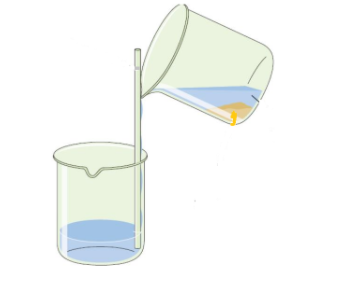
Which technique is shown in the diagram above?

(A) sieving
(B) filtration
(C) decanting
(D) crystallization

Answer
504.3k+ views
Hint: The various constituents of a mixture have different physical properties such as density, solubility, size of particles, behavior towards a magnet, volatility, boiling point, etc. the difference in the physical properties of constituents is used to separate them from the mixture.
Complete answer:
The separation of mixtures consider three cases:
(1) a mixture of two solids
(2) a mixture of solid and liquid
(3) a mixture of two liquids.
Let us check the separation methods and which method will be matched to the given diagram!
(A) Sieving: sometimes to prepare a dish with flour, I need to remove impurities and bran that may be present in it. Then prefer sieve and pour flour into it. This process allows then fine flour particles to pass through the holes of the sieve while bigger impurities remain on the sieve. This method is used for the separation of solid substances.
(B) filtration: let us consider a mixture of a solid and liquid. After preparing tea, to remove all tea leaves remaining in the container, the process is called filtration. This is the best method of separation to remove insoluble impurities like soil from water.
(C) decantation: this is the process of allowing a mixture of solid and liquid or two immiscible liquids to settle and separate by gravity. The mixture to be separated is gradually poured from one container into another, which separates further sedimentation processes.
(D) crystallization: the process of cooling a hot, concentrated solution of a substance to obtain crystals is called crystallization. It is used to obtain a pure sample from an impure sample. For example, impure copper sulfate can be purified by the method of crystallization.
From the above four processes, the above diagram represents the decanting technique.
Hence the correct option is B.
Note:
There are many instances when we notice a substance being separated from a mixture of materials. Handpicking, winnowing, sieving, sedimentation, decantation, condensation, and filtration are some of the methods of separating substances from their mixtures.
Complete answer:
The separation of mixtures consider three cases:
(1) a mixture of two solids
(2) a mixture of solid and liquid
(3) a mixture of two liquids.
Let us check the separation methods and which method will be matched to the given diagram!
(A) Sieving: sometimes to prepare a dish with flour, I need to remove impurities and bran that may be present in it. Then prefer sieve and pour flour into it. This process allows then fine flour particles to pass through the holes of the sieve while bigger impurities remain on the sieve. This method is used for the separation of solid substances.
(B) filtration: let us consider a mixture of a solid and liquid. After preparing tea, to remove all tea leaves remaining in the container, the process is called filtration. This is the best method of separation to remove insoluble impurities like soil from water.
(C) decantation: this is the process of allowing a mixture of solid and liquid or two immiscible liquids to settle and separate by gravity. The mixture to be separated is gradually poured from one container into another, which separates further sedimentation processes.
(D) crystallization: the process of cooling a hot, concentrated solution of a substance to obtain crystals is called crystallization. It is used to obtain a pure sample from an impure sample. For example, impure copper sulfate can be purified by the method of crystallization.
From the above four processes, the above diagram represents the decanting technique.
Hence the correct option is B.
Note:
There are many instances when we notice a substance being separated from a mixture of materials. Handpicking, winnowing, sieving, sedimentation, decantation, condensation, and filtration are some of the methods of separating substances from their mixtures.
Recently Updated Pages
Master Class 12 Business Studies: Engaging Questions & Answers for Success

Master Class 12 English: Engaging Questions & Answers for Success

Master Class 12 Social Science: Engaging Questions & Answers for Success

Master Class 12 Chemistry: Engaging Questions & Answers for Success

Class 12 Question and Answer - Your Ultimate Solutions Guide

Master Class 11 Economics: Engaging Questions & Answers for Success

Trending doubts
Draw a labelled sketch of the human eye class 12 physics CBSE

a Tabulate the differences in the characteristics of class 12 chemistry CBSE

Which one of the following is a true fish A Jellyfish class 12 biology CBSE

Why is the cell called the structural and functional class 12 biology CBSE

Differentiate between homogeneous and heterogeneous class 12 chemistry CBSE

Write the difference between solid liquid and gas class 12 chemistry CBSE




